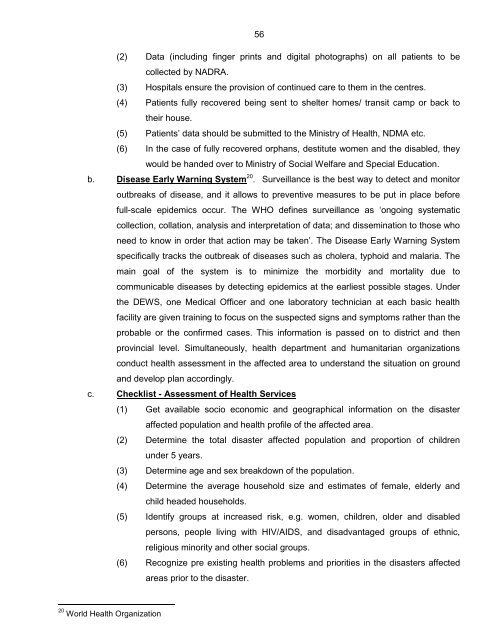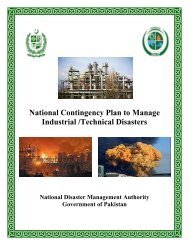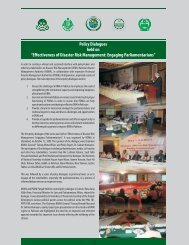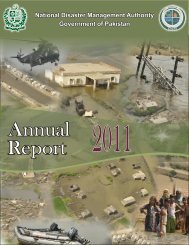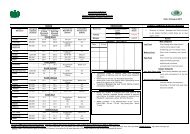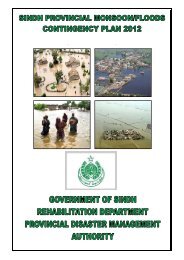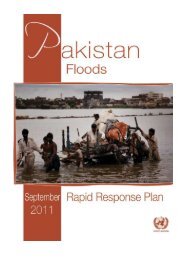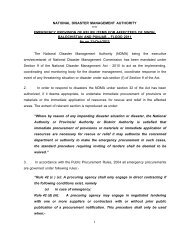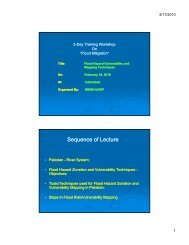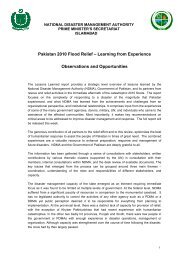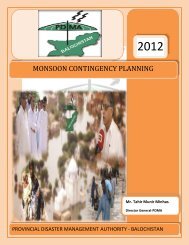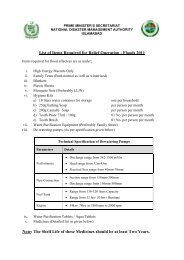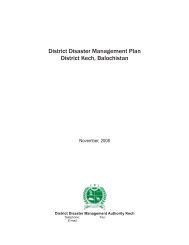National Disaster Response Plan (NDRP) March 2010 - NDMA
National Disaster Response Plan (NDRP) March 2010 - NDMA
National Disaster Response Plan (NDRP) March 2010 - NDMA
Create successful ePaper yourself
Turn your PDF publications into a flip-book with our unique Google optimized e-Paper software.
56<br />
(2) Data (including finger prints and digital photographs) on all patients to be<br />
collected by NADRA.<br />
(3) Hospitals ensure the provision of continued care to them in the centres.<br />
(4) Patients fully recovered being sent to shelter homes/ transit camp or back to<br />
their house.<br />
(5) Patients‟ data should be submitted to the Ministry of Health, <strong>NDMA</strong> etc.<br />
(6) In the case of fully recovered orphans, destitute women and the disabled, they<br />
would be handed over to Ministry of Social Welfare and Special Education.<br />
b. Disease Early Warning System 20 . Surveillance is the best way to detect and monitor<br />
outbreaks of disease, and it allows to preventive measures to be put in place before<br />
full-scale epidemics occur. The WHO defines surveillance as „ongoing systematic<br />
collection, collation, analysis and interpretation of data; and dissemination to those who<br />
need to know in order that action may be taken‟. The Disease Early Warning System<br />
specifically tracks the outbreak of diseases such as cholera, typhoid and malaria. The<br />
main goal of the system is to minimize the morbidity and mortality due to<br />
communicable diseases by detecting epidemics at the earliest possible stages. Under<br />
the DEWS, one Medical Officer and one laboratory technician at each basic health<br />
facility are given training to focus on the suspected signs and symptoms rather than the<br />
probable or the confirmed cases. This information is passed on to district and then<br />
provincial level. Simultaneously, health department and humanitarian organizations<br />
conduct health assessment in the affected area to understand the situation on ground<br />
and develop plan accordingly.<br />
c. Checklist - Assessment of Health Services<br />
20 World Health Organization<br />
(1) Get available socio economic and geographical information on the disaster<br />
affected population and health profile of the affected area.<br />
(2) Determine the total disaster affected population and proportion of children<br />
under 5 years.<br />
(3) Determine age and sex breakdown of the population.<br />
(4) Determine the average household size and estimates of female, elderly and<br />
child headed households.<br />
(5) Identify groups at increased risk, e.g. women, children, older and disabled<br />
persons, people living with HIV/AIDS, and disadvantaged groups of ethnic,<br />
religious minority and other social groups.<br />
(6) Recognize pre existing health problems and priorities in the disasters affected<br />
areas prior to the disaster.


